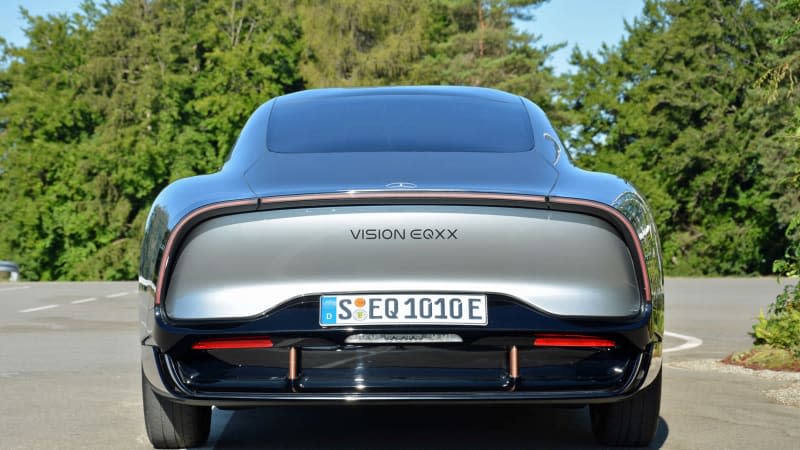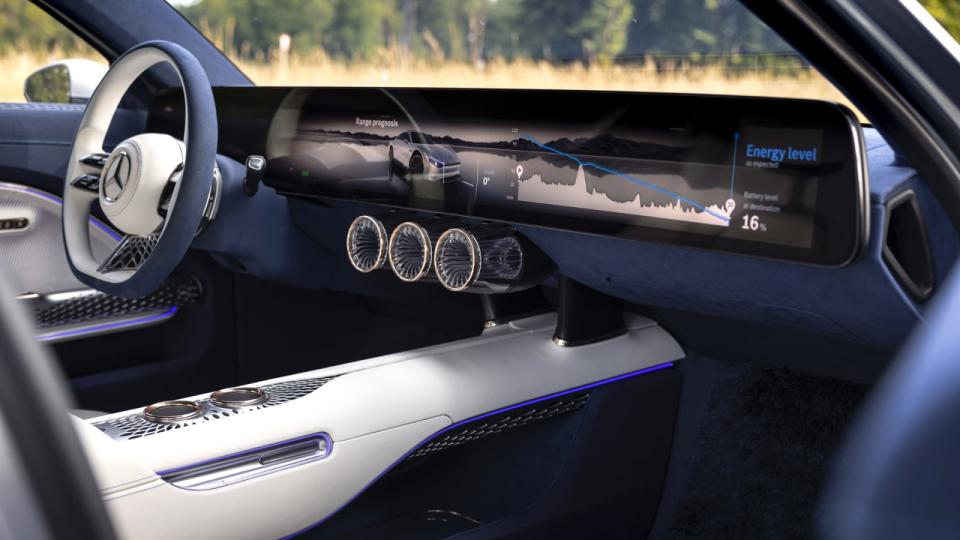Mercedes-Benz EQXX First Drive: The Mercedes EV benchmark for years to come

“Now that it’s out, you can’t put it back in the box. This car is now in the room whenever anyone is talking about what’s possible and what’s not. It changes what you think is acceptable, and it changes your targets a bit.” That's Malte Sievers, one of the Mercedes-Benz Vision EQXX’s project managers, talking about this achievement of a car.
Sievers was part of a small group given a simple-sounding task that was exceptionally difficult: Build an electric car capable of driving for over 1,000 kilometers (around 621 miles) on a single charge. In a gasoline- or diesel-powered car, achieving a 600-plus-mile driving range is easy: Fit a bigger (or a second) fuel tank and call it a good job well done. In an electric car, it’s much harder.
The team pulled it off. Unveiled in January 2022, the EQXX proved in April that it’s capable of breaking the 1,000-kilometer barrier by driving from Stuttgart, Germany, to Cassis, France, without stopping to charge. It headed to England and broke its own record by about 125 miles in June. It’s destined to remain a prototype, a rolling display of technology not designed or fit for mass production, but it will bring Mercedes-Benz engineers more than bragging rights. Many of the lessons learned during the project will influence the electric cars that the German company plans to release later in the 2020s.
I traveled to Germany to drive the EQXX and chat with some of the folks who developed it.
Mercedes launched the EQXX project in 2020. The only guideline it gave the men and women assigned to it was to find a way to cross the 1,000-kilometer mark. Projects like this aren’t common, but a look through the company’s history confirms that they’re also not unusual. We’ve seen several high-tech proof-of-concept-type experiments roll out of Stuttgart, including the Auto 2000 from 1981. While many previous projects focused on safety, the EQXX’s emphasis on range required starting with a blank slate.
“Efficiency in the age of electric vehicles is very much about looking at every single part of the car,” Sievers said. “You need to improve every single area. Everything that has a weight needs to become lighter, everything that transfers energy needs to become more efficient, and everything that’s on the outside needs to be as aerodynamic as possible.” Several departments collaborated to make it happen.
The most important factor that affects efficiency, and in turn range, is aerodynamic drag. Designers achieved a 0.17 drag coefficient while retaining a shape that resembles a car (rather than a rocket with wheels), which is remarkable. By comparison, the most aerodynamic series-produced car that Mercedes has ever released is the electric EQS sedan, which posts a drag coefficient of 0.20. Leaping from, say, 0.30 to 0.20 requires a great deal of effort but it’s not terribly complicated. The jump from 0.20 to 0.17 is smaller but it’s a significant challenge. It helps that the EQXX is an EV: It doesn’t need a grille, which increases drag, to channel cooling air into the engine bay. Active aerodynamic parts come into play as well, such as a rear diffuser that lowers and extends either automatically or manually via a menu in the touchscreen.


Making the drivetrain as efficient as possible required clearing several hurdles. Power for the EQXX comes from a rear-mounted motor that draws electricity from a sub-100-kilowatt-hour lithium-ion battery pack to zap the back wheels with 201 horsepower. It’s a unit called eATS 2.0 internally, and it’s currently being developed for the next generation of Mercedes-Benz EVs due out later in the 2020s.
“We took it fully apart, looked into every single aspect of it, and optimized it as far as we could,” Sievers said. His team achieved an efficiency rating of 95%, meaning that 95% of the energy stored in the battery pack makes it to the wheels. By comparison, the EQS posts an efficiency rating of roughly 90%.
Solar panels integrated into the roof help channel electricity to the battery pack. They add weight, but the tradeoff was worth it. When the EQXX covered the 747 miles separating Stuttgart and Silverstone, England, the 117-cell solar setup contributed approximately 26 miles of driving range.
Speaking of weight, reducing it is a proven way of improving efficiency. The EQXX tips the scale at 3,858 pounds, which is an impressive figure for an EV. Mercedes-Benz tapped into its vast Formula 1 expertise to achieve that figure.
“High Performance Powertrains, which provides drivetrains to the Formula 1 team, built the battery and the inverter,” Sievers said. “On the Formula 1 side, our team has engineers that specialize in carbon fiber and they provided parts like the battery’s lid as well as the subframe that the motor sits in.”
The powertrain was ready before the body, so engineers stuffed it inside an EQB-based test mule that they nicknamed Emma to put it through its paces. Champagne bottle caps glued to the underside of the hood mark Emma’s major achievements, like the day it moved under its own power for the first time.


 Yahoo Autos
Yahoo Autos 
